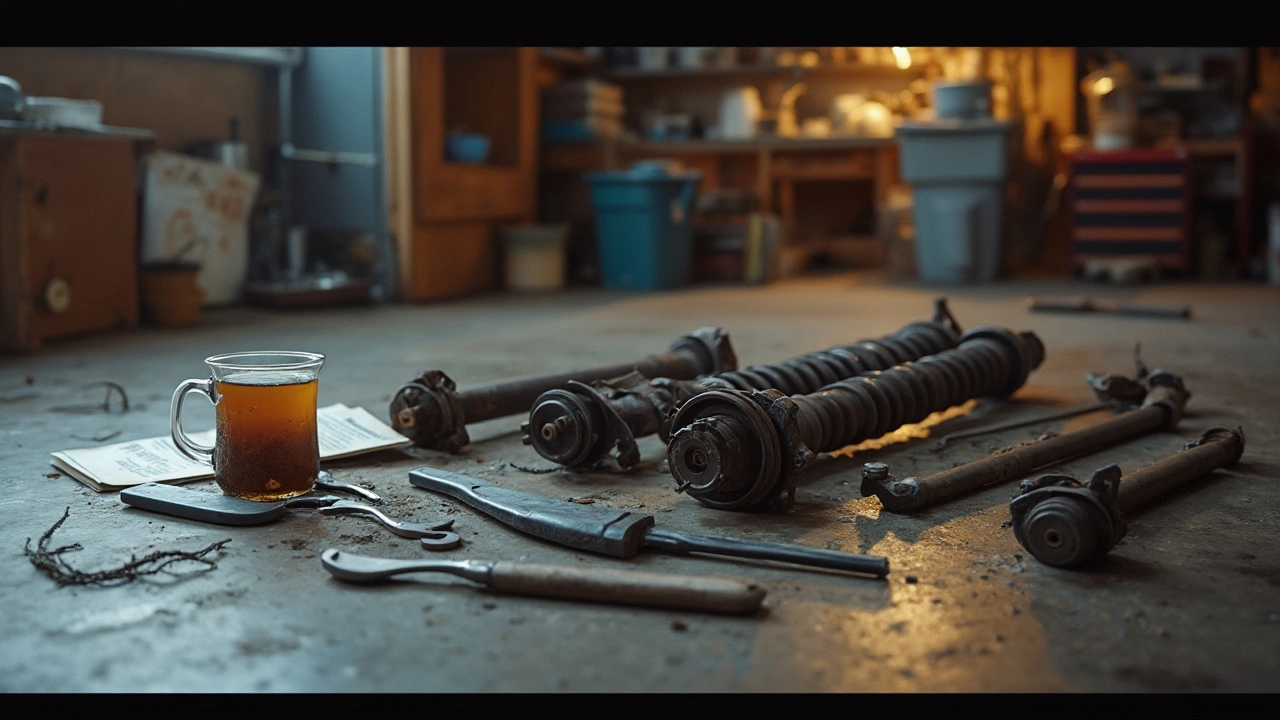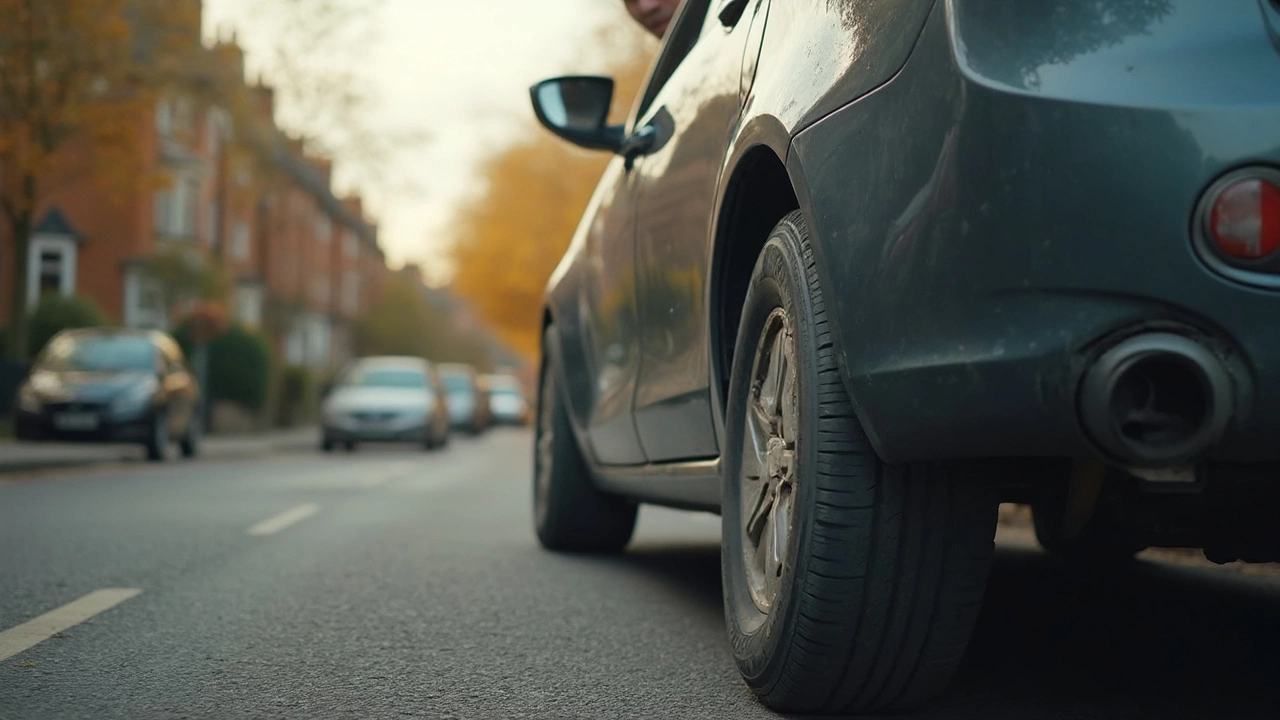Imagine driving on a bumpy road—every pothole rattling your teeth. That’s what bad suspension feels like, and it creeps up faster than you might think. Most drivers ignore those first few squeaks and rattles, chalking it up to bad roads or old age. But catching busted suspension early isn’t about comfort—it’s about safety.
Your suspension system does way more than just keep the ride smooth. It keeps your tires in contact with the pavement (which means you actually stop when you hit the brakes). When it starts to go, small signals pop up first—maybe the car nose-dives when you brake, or leans like a boat around turns. You don’t have to be a mechanic to spot these clues if you know what to look for.
Ever noticed weird tire wear, even though your alignment is spot on? Or does your steering feel oddly loose, like the car has a mind of its own? These aren’t just quirks. They’re big red flags that your shocks, struts, or other parts might be wearing out. Most people live with dodgy suspension for months, risking more repairs down the line.
- How Suspension Actually Works
- Warning Signs Your Suspension Needs Attention
- DIY Checks You Can Do at Home
- What Worn Suspension Feels Like
- When to Replace vs. Repair
- Cost and Parts Tips
How Suspension Actually Works
Most folks just think of suspension as the springs and shocks under their car, but it’s a whole system working together to keep you safe and comfortable. Your car’s suspension connects the wheels to the rest of the vehicle and manages how it handles bumps, corners, and even how well it brakes.
Here’s what’s really going on. The suspension absorbs the impact from the road through three main parts: springs, shock absorbers (or struts), and various connection arms (like control arms and bushings). The springs support the weight and soak up the big hits, while the shocks control how fast the springs move, keeping your ride planted. Control arms and bushings keep everything aimed right. Without this setup, every bump would send your car bouncing and swaying all over the place. Ever wondered why race cars handle so flat? That's down to super-stiff, dialed-in suspension parts.
- Springs: Usually coil or leaf, they hold up your car and handle the worst of the road.
- Shock absorbers (struts): These control the up-and-down motion, so you’re not bouncing forever after each bump.
- Control arms & bushings: These link everything together and help guide your tires’ path as the car moves.
Suspension plays a huge role in suspension replacement decisions; replacing just one worn item can sometimes mess up the system’s balance. Safety’s on the line here, too—worn suspension parts can turn a sharp stop into a sliding scare or make your car veer on tight turns. According to a 2023 safety study, vehicles with bad shocks had a 30% longer stopping distance at high speeds compared to those with new suspension parts.
| Suspension Part | Main Job | Common Lifespan (Miles) |
|---|---|---|
| Shock Absorbers | Control car bounce | 50,000 - 100,000 |
| Springs | Absorb impacts | Up to 150,000 |
| Bushings | Reduce vibration | 70,000 - 100,000 |
The guts of the system aren’t out of sight, out of mind. When one part starts to fail, the rest feel the strain. That’s why mechanics usually check all pieces before signing off on repair. Knowing how these parts work makes it a heck of a lot easier to know when something’s up—and when it’s time to swap out those tired old parts before a bigger problem hits.
Warning Signs Your Suspension Needs Attention
If you’re wondering whether your suspension needs some love, the signs are usually right in front of you—even if you’ve gotten used to them. The symptoms show up not just in how your car feels, but in how it looks and sounds, too.
- suspension replacement becomes necessary if you start hearing clunking or squeaking noises when you hit bumps. This is often a dead giveaway that parts like shocks, struts, or bushings are worn out.
- Does your car bounce a lot after you hit a bump? Try the old-school bounce test. Push down hard on the hood or trunk and let go. If your vehicle bounces more than a couple of times, your shocks or struts are tired.
- Pay attention to steering. If it seems loose, or you feel every dip and pothole extra hard, your suspension is probably not doing its job.
- Crooked or sagging stance is another flag. If one side of your car sits lower than the other, it can mean a busted spring.
- Braking can tell you a lot, too. If your car nose-dives when you hit the brakes, or it pulls to one side, the suspension’s not controlling your car’s weight properly.
- Uneven tire wear is a silent but serious sign. If your tire treads look oddly worn (even with good alignment), weak suspension could be the root cause.
According to the Car Care Council, “A vehicle’s suspension is key for control and safety—worn parts reduce braking stability and handling.”
The National Highway Traffic Safety Administration says: “A healthy suspension helps ensure tires stay in contact with the road, especially when braking or turning sharply.”
If you notice more than one of these signs, don’t wait. Small suspension problems often snowball into bigger, more expensive headaches and can hurt your safety on the road.
DIY Checks You Can Do at Home
You don’t need a lift or a toolbox full of fancy stuff to spot most suspension replacement needs. There are simple tests you can run in your driveway that might save you from a big repair down the road.
Bounce Test: Walk to one corner of your car, push down hard on the fender, and let go. The car should spring back smoothly and settle. If it keeps bouncing more than once or twice, your shocks or struts are worn out.
Tire Wear Check: Uneven tire wear patterns, like bald spots or excessive wear on one edge, likely means poor suspension. For example, shocks that are shot will usually cause what’s called "cupping"—a scalloped pattern on the tire tread.
Visual Inspection: Bend down and look inside the wheel well. If you see oily residue on the outside of a shock absorber or strut, that means it's leaking and needs to go. Also, check for any obvious broken or hanging parts—suspension springs should never be cracked or split.
Listen Up: Drive slowly over a speed bump or through a pothole with your windows down. Squeaks, clunks, or metallic knocks are a big hint something’s loose or broken.
Here’s a quick table so you know what to look for and what it might mean:
| DIY Check | What to Look For | Possible Suspension Problem |
|---|---|---|
| Bounce Test | Car bounces more than twice after pushing down | Worn shocks/struts |
| Tire Wear | Cupping or uneven edges on tires | Poor shock absorption, bad alignment |
| Visual Inspection | Oil on shocks, broken springs | Leaky or damaged parts |
| Listen for Noises | Squeaks, clunks on bumps | Loose or broken components |
Tip: None of these checks take more than 15 minutes but they could help you spot an expensive fix before it gets worse. If you’re ever unsure, take a quick video or photo and show it to a mechanic—they’ll usually tell you in seconds if something’s way off.

What Worn Suspension Feels Like
Worn out suspension parts don’t just take away comfort—they actually mess with how well your car drives and handles. Most people notice something’s off when their car starts acting weird after hitting bumps. If it feels like your car is bouncing more than usual or sways way too much in turns, it’s a classic sign parts like your struts or shock absorbers are on their last legs.
Here are the most common ways a busted suspension shows up while driving:
- Suspension replacement: If your ride feels bouncy—even just cruising down a fairly smooth road—that’s a top clue. Good suspension will settle quickly after a bump. Bad suspension just keeps bouncing.
- You feel a harsh jolt from every pothole or speed bump. It’s like the car stopped filtering out road flaws.
- Braking makes your nose dip or "dive" down, even when you don’t slam the brakes. That means the front shocks can’t hold up the weight transfer.
- The car feels unsettled or floats side to side, especially at higher speeds or when changing lanes. That’s your suspension failing to control the car’s motion.
- It might lean like a sailboat in the wind when you take a turn—not just in tight corners but even in mild bends.
You’ll see some of these issues show up in tire wear. If your tires have uneven wear, cupping, or bald spots and you’ve kept up with rotations and alignment, the suspension is probably at fault. Here’s a quick table showing signs and what they usually mean:
| Feeling/Symptom | Possible Suspension Problem |
|---|---|
| Bouncy ride, keeps bouncing after bumps | Blown shocks/struts |
| Excess diving under braking | Worn front shocks/struts |
| Sways, leans, loose in corners | Failed shocks/struts, bad bushings |
| Harsh or jarring bumps | Shocks have lost damping, bushings worn out |
| Weird tire wear patterns | Tired suspension parts, possibly alignment issues from bad suspensions |
Stats say most shocks and struts start losing effectiveness after about 50,000 miles. But how fast they wear out depends on your driving and where you live—rougher roads chew through suspension faster. Don’t ignore that weird, floaty feeling or a ride that’s suddenly rougher. Long story short: If your car feels unpredictable, or you’re fighting to keep it in a straight line, those parts are cooked.
When to Replace vs. Repair
This is where most folks get stuck—should you replace the whole part, or just fix what’s broken? It depends on the problem and how much wear things already have. If you’ve got a leaky shock, a damaged strut, or a broken spring, replacement is usually the way to go. Patch jobs on suspension don’t last, and a half-fixed suspension system can throw off your car’s handling and burn through your tires faster.
You can spot simple repair jobs, like bushings or boots that have cracked or worn out. These are usually cheap to replace and can squeeze a bit more life from the more expensive parts around them. But with shocks or struts, if the fluid’s leaking or you can push your car down and it bounces more than twice, it’s time for new parts. And don’t forget: replacing parts in pairs (left and right together) keeps things balanced. One new shock and one old one just don’t mix.
Take a look at this quick breakdown of the typical lifespan and warning signs by part:
| Part | Average Lifespan (Miles) | Telltale Signs | Repair or Replace? |
|---|---|---|---|
| Shock Absorbers | 50,000–100,000 | Leaking fluid, excessive bounce, poor handling | Replace |
| Struts | 50,000–100,000 | Noisy ride, sagging, nose dive when braking | Replace |
| Control Arm Bushings | 90,000+ | Clunks, loose steering, uneven tire wear | Repair/Replace Bushing |
| Coil Springs | 100,000+ | Car sits low, creaking, uneven ride height | Replace |
Cost can sway the decision. Sometimes, the price difference between fixing a single bushing and swapping out the whole control arm is so small that going for new makes sense for peace of mind. But for expensive parts, you might try a bushing or boot repair first if the rest of the assembly is still solid.
The big thing? If your suspension replacement is overdue, don’t wait for a total failure. Waiting can chew up your tires, mess with your brakes, and even push other parts to break. Safety should trump saving a few bucks on patch jobs.
Cost and Parts Tips
Let’s talk about the money side of things—because nothing ruins your mood faster than finding out new shocks or struts cost more than your last vacation. First off, costs can swing a lot depending on your car. Brands like Toyota and Honda tend to have cheaper aftermarket options, while a fancy Audi or BMW will chew a bigger hole in your wallet. If you’re driving a pickup or SUV, expect to shell out a bit more, especially for things like heavy-duty struts or coil springs.
For the basics, here’s a rundown you can use for quick reference:
| Suspension Part | Average Cost per Part | Typical Labor Cost |
|---|---|---|
| Shock Absorber (single) | $60-$200 | $80-$140 |
| Strut Assembly (single) | $150-$350 | $100-$250 |
| Control Arm | $100-$300 | $120-$300 |
| Ball Joint | $30-$70 | $100-$200 |
Now, here are some tips to stretch your dollar and stay safe:
- Always replace pairs—both front or both rear. Replacing one side only can mess with handling and wear out the new part faster.
- If you want to save on labor, some jobs (like shocks on older cars) are doable with basic tools, but struts or anything near springs usually need special gear. Don’t mess with those if you’re not sure; coil springs pack a punch.
- If you see a cheap part that looks too good to be true online, check reviews and the warranty. Good suspension parts aren’t the place to go bargain hunting—they directly affect your safety.
- Ask your mechanic if there’s a difference between original (OEM) and aftermarket. Sometimes aftermarket works fine, but for high-mileage cars, sticking to OEM might save headaches later.
One thing people forget: after swapping suspension parts, get your wheels aligned. A bad alignment chews up new tires, eats into fuel mileage, and can even wreck your shiny new suspension parts quicker than you’d expect.
If you really want to get your money’s worth, keep an eye on deals for full kits. Buying all four shocks or struts in a bundle can sometimes knock off 20-30% compared to buying them one at a time.
Replacing your suspension parts is a pain, but cutting corners can cost more in the long run. Spending a bit more upfront keeps your ride safe, smooth, and way less stressful on those pothole-filled roads.

